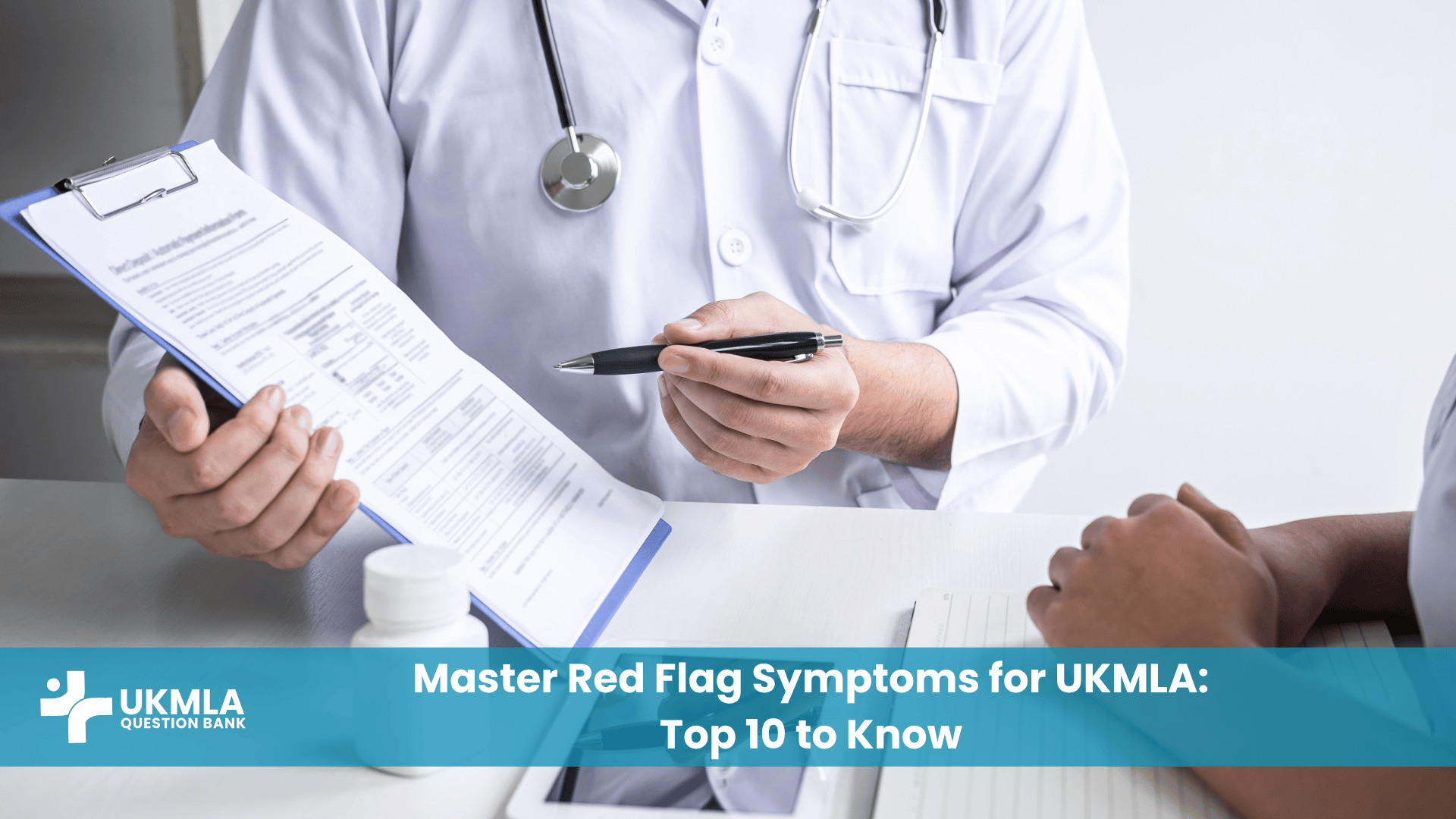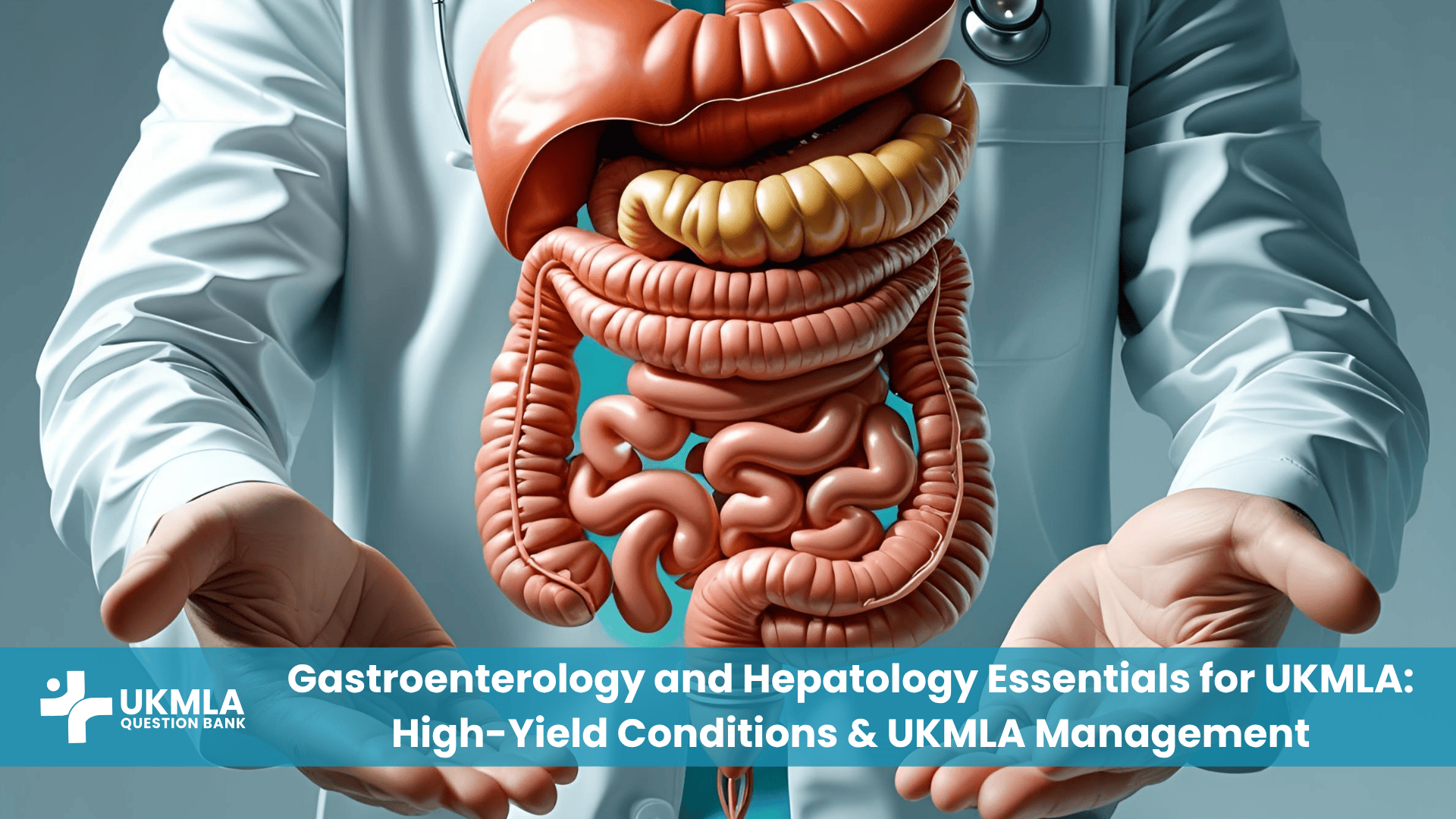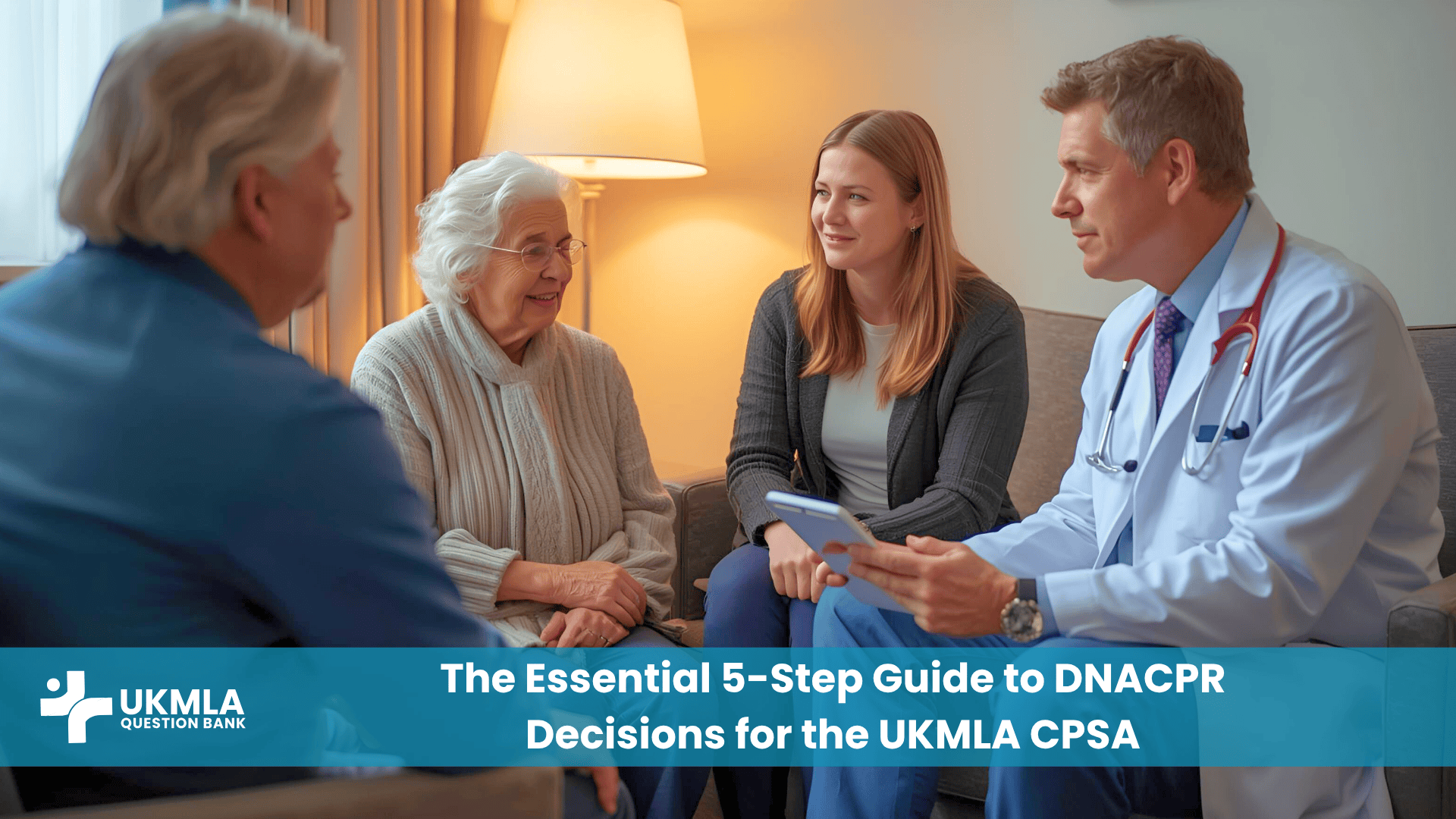Introduction
Mastering the recognition of red flag symptoms for UKMLA is not just an exam technique; it is the single most important skill for ensuring patient safety as a junior doctor. The UK Medical Licensing Assessment (UKMLA) places an enormous emphasis on your ability to identify signs of serious underlying pathology and act appropriately. These questions are designed to test your clinical prioritisation skills—can you spot the sickest patient in the room and do the right thing, right now?
This guide is designed to be your essential, high-yield resource for this critical topic. We will cut through the noise to focus on the top 10 “must not miss” red flag presentations that are frequently tested in the AKT (Applied Knowledge Test). For each one, we will break down the classic presentation, the life-threatening diagnosis you must consider, and the immediate actions required.
Table of Contents
ToggleThe Top 10 Red Flag Symptoms for UKMLA You Must Not Miss
This list covers the most critical red flag presentations. For each one, your ability to recognise the pattern and initiate the correct action is paramount.
1. The “Thunderclap” Headache
The Classic Presentation: A patient describes a headache that is sudden, severe, and reaches its maximum intensity within seconds to a minute. They often describe it as “being hit over the back of the head.” It may be associated with neck stiffness, photophobia, or a reduced level of consciousness.
The “Must Not Miss” Diagnosis: Subarachnoid Haemorrhage (SAH). This is a neurosurgical emergency, often caused by a ruptured cerebral aneurysm.
The Immediate Action Required: This patient needs immediate transfer to an emergency department. The first-line investigation is an urgent non-contrast CT head. If the CT is negative but the clinical suspicion remains high (especially if the headache started >6 hours ago), a lumbar puncture is performed to look for xanthochromia (the yellow discolouration from bilirubin breakdown products).
2. Signs of Cauda Equina Syndrome
The Classic Presentation: A patient presents with low back pain accompanied by any of the following bilateral symptoms: sciatica, leg weakness, or sensory loss. The most specific red flags are saddle anaesthesia (numbness in the perineal area), bladder dysfunction (urinary retention or incontinence), and bowel dysfunction (faecal incontinence or loss of sensation).
The “Must Not Miss” Diagnosis: Cauda Equina Syndrome, which is compression of the nerve roots at the base of the spinal cord. This can be caused by a large central disc prolapse, tumour, or abscess.
The Immediate Action Required: This is another critical neurosurgical emergency. The patient requires an immediate emergency department referral for an urgent MRI spine. Any delay can result in permanent neurological damage, including paralysis and incontinence. For more on this, our guide to high-yield musculoskeletal topics is highly relevant.
3. Acute, Painful Red Eye with Vision Loss
The Classic Presentation: A patient, often elderly and long-sighted, presents with a sudden onset of a severely painful, red eye. This is associated with blurred vision (often described as seeing “haloes” around lights), headache, nausea, and vomiting.
The “Must Not Miss” Diagnosis: Acute Angle-Closure Glaucoma. This occurs when the iris bows forward and blocks the drainage of aqueous humour, causing a rapid and dangerous rise in intraocular pressure.
The Immediate Action Required: This is an ophthalmological emergency that can lead to permanent blindness if not treated promptly. The patient needs an emergency referral to an ophthalmologist. Immediate management in the ED may include lying the patient supine and giving medications like IV acetazolamide to lower the intraocular pressure.
4. Sudden Onset, Tearing Chest Pain Radiating to the Back
The Classic Presentation: A patient, often with a history of hypertension, describes a sudden, severe chest pain that they describe as “tearing” or “ripping” in nature. Crucially, the pain often radiates through to their back, between the shoulder blades.
The “Must Not Miss” Diagnosis: Aortic Dissection. This is a tear in the intima of the aorta, allowing blood to track between the layers of the aortic wall.
The Immediate Action Required: This is a life-threatening surgical emergency. The immediate actions involve an ABCDE assessment, securing IV access, and getting an urgent CT aortogram. A key examination finding can be a difference in blood pressure between the two arms. For more on this, our guide on Emergency Medicine Essentials is a vital resource.
5. Haemoptysis in a Smoker
The Classic Presentation: An older patient with a significant smoking history presents with a new or changing cough and reports coughing up blood (haemoptysis). This may be associated with other red flags like unintentional weight loss, persistent chest pain, or finger clubbing.
The “Must Not Miss” Diagnosis: Lung Cancer until proven otherwise.
The Immediate Action Required: This patient meets the criteria for an urgent 2-week-wait referral for a chest X-ray, as per the NICE guidelines. This is a classic test of your knowledge of referral pathways.
6. Post-menopausal Bleeding
The Classic Presentation: Any vaginal bleeding in a woman who has been through the menopause (defined as >12 months without a period).
The “Must Not Miss” Diagnosis: Endometrial Cancer until proven otherwise. While the cause is often benign (e.g., atrophy), malignancy must be excluded.
The Immediate Action Required: This is another classic urgent 2-week-wait referral, this time to gynaecology for a transvaginal ultrasound scan (TVUSS) to assess the endometrial thickness.
7. A Non-blanching Rash
The Classic Presentation: A patient, often a child or young adult, presents with a fever and is unwell. On examination, they have a rash that does not disappear when a glass is pressed against it (the “glass test”).
The “Must Not Miss” Diagnosis: Meningococcal Septicaemia. This is a life-threatening bacterial infection.
The Immediate Action Required: This is a critical medical emergency. If you suspect meningococcal disease in a primary care setting, the immediate action is to give a stat dose of parenteral antibiotics (e.g., IV or IM Benzylpenicillin) before arranging an emergency hospital transfer. Do not delay this for any reason.
Clinical Pearl: “The non-blanching rash of meningococcal disease is often a late sign. A feverish child who is becoming drowsy or difficult to rouse should be treated as having sepsis until proven otherwise, even if they don’t have a rash.”
8. Unintentional Weight Loss with a Change in Bowel Habit
The Classic Presentation: An older patient (typically >60) reports a persistent change in their bowel habit (e.g., new, looser stools or constipation) lasting for several weeks, often associated with unintentional weight loss or rectal bleeding.
The “Must Not Miss” Diagnosis: Colorectal Cancer.
The Immediate Action Required: This is another scenario requiring an urgent 2-week-wait referral to gastroenterology for a colonoscopy.
9. A New Onset Seizure in an Adult
The Classic Presentation: An adult with no prior history of epilepsy presents with a first seizure.
The “Must Not Miss” Diagnosis: While there are many causes, you must exclude a serious underlying intracranial pathology, such as a brain tumour, a bleed, or an infection.
The Immediate Action Required: The patient requires urgent assessment in hospital, including a neurological examination and consideration of urgent neuroimaging (usually a CT or MRI head).
10. A Limping Child with a Fever
The Classic Presentation: A young child presents with a limp or is refusing to bear weight on one leg, and they have a fever. The affected joint may be swollen, warm, and is often held in a fixed position.
The “Must Not Miss” Diagnosis: Septic Arthritis. This is an orthopaedic emergency, as infection can rapidly destroy the joint cartilage.
The Immediate Action Required: This child needs an emergency referral to the paediatric orthopaedic team for assessment and probable joint aspiration in theatre.
A Framework for Prioritising Red Flags in the AKT
SBA (Single Best Answer) questions will often present a clinical scenario and ask for the most appropriate next step. Your ability to prioritise is key.
A Note on Safety: “In the UKMLA, the safest answer is almost always the right answer. If one of the options is to arrange an urgent investigation or referral to rule out a serious condition, it is very likely to be the correct choice.”
The “Safety First” Principle: When you read a vignette, your first mental task should be to scan for any of the red flags listed above. If one is present, your management plan must prioritise addressing it.
Differentiating Referrals: You must know the difference between a routine, urgent, and emergency referral. The NICE guideline (NG12) on “Suspected cancer: recognition and referral” is the definitive UK source for the 2-week-wait pathways and is essential reading.
Table 1: Understanding Referral Urgency
| Urgency | Timeframe | Example Scenario |
|---|---|---|
| Emergency | Immediate (minutes to hours) | A patient with a suspected “thunderclap” headache. |
| Urgent | Within 2 weeks | A 65-year-old smoker with new haemoptysis. |
| Routine | Weeks to months | A young patient with mechanical back pain and no red flags. |
Frequently Asked Questions (FAQ): Red Flag Symptoms
The presence of multiple red flags increases the likelihood of serious pathology and adds to the urgency of the situation. You should clearly document all of them and communicate them in your referral.
Be calm, clear, and honest. You can say, “Based on your symptoms, I think it’s important that we get you seen by the specialists at the hospital today to get to the bottom of this quickly. I will arrange that for you now.”
Yes. This term is often used, particularly in paediatrics, to describe features that are not immediately life-threatening but indicate a patient is at intermediate risk and requires a “safety net” (clear advice on when to seek further help) or a follow-up appointment.
While all are important, any symptom or sign that suggests immediate compromise of the Airway, Breathing, or Circulation (the ABCs) is the absolute priority. A patient with a new seizure is a neurological red flag, but a patient with a tension pneumothorax has an airway and breathing emergency that will kill them faster.
Age is a crucial factor. For example, a change in bowel habit in a 20-year-old is much less likely to be cancer than the same symptom in a 70-year-old. Conversely, a headache is common, but a “thunderclap” headache is a red flag at any age.
This is a classic exam scenario. If your clinical suspicion remains high despite a normal initial test (e.g., a patient with a classic story for a scaphoid fracture but a normal X-ray), the answer is often to proceed with further investigation or to treat as if the condition is present and review.
Don’t try to memorise them as a separate list. Integrate them into your learning. When you revise a condition like colorectal cancer, make learning the red flag symptoms for a 2-week-wait referral a core part of that revision.
Experienced clinicians often talk about a “gut feeling” that a patient is unwell. This is often the subconscious recognition of a pattern of subtle signs. For the UKMLA, you should rely on the objective red flags, but always pay attention in a vignette if it mentions that a parent is “very worried” or a patient “just doesn’t look right.”
The NICE NG12 guideline is the key document. It summarises the specific symptoms and signs for different cancer types that should trigger an urgent referral. You should be familiar with the main ones.
The best way is to use a high-quality UKMLA question bank. Work through hundreds of clinical scenarios. For each one, actively ask yourself, “Are there any red flags here? What is the single most important thing I must not miss?”. This will build the safe clinical reasoning skills you need.
Conclusion
Mastering the top 10 red flag symptoms for UKMLA is about embedding a “think worst first” mentality into your clinical reasoning. In the pressure of the AKT and in your future practice, your ability to spot the subtle signs of a subarachnoid haemorrhage, an aortic dissection, or a septic child is what defines you as a safe doctor.
Use this guide to focus your revision on these critical presentations. Learn the patterns, know the immediate actions, and always prioritise patient safety above all else. This approach will not only help you excel in your exam but will form the foundation of a safe and successful medical career.




